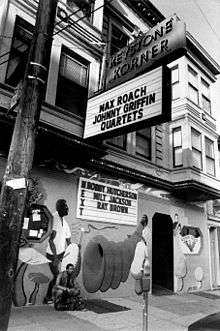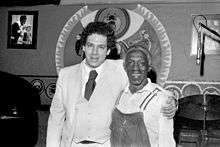Keystone Korner
 Odean Pope in front of Keystone Korner, 1982 | |
| Location |
750 Vallejo Street San Francisco, California United States |
|---|---|
| Coordinates | 37°47′55″N 122°24′34″W / 37.798586°N 122.409374°WCoordinates: 37°47′55″N 122°24′34″W / 37.798586°N 122.409374°W |
| Owner | Todd Barkan |
| Type | Nightclub |
| Genre(s) | Jazz |
| Capacity | 200 |
| Opened | 1972 |
| Closed | 1983 |
Keystone Korner was an important jazz music club in the North Beach neighborhood of San Francisco, which opened in 1972 and continued operation until 1983. Many live recordings were made at the club.[1] Jessica Williams was the house pianist for a number of years.
History
In 1969, Freddie Herrera bought Dino and Carlo's Bar in the North Beach section of San Francisco. He changed the name of the bar to Keystone Korner, a reference to Keystone Cops, because of its proximity to the Central Police Station on the opposite corner of Emery Lane.[2]
Keystone Korner started out as a topless bar, but quickly changed direction when songwriter Nick Gravenites convinced Herrera that live music would bring in more customers. The strength of the music scene in San Francisco allowed Herrera to book young musicians who would go on to stellar careers. Patrons filled the club to hear such new talents as Elvin Bishop, Neal Schon, Boz Scaggs, and The Pointer Sisters. Herrera's success made it possible to move across the San Francisco Bay and open a larger room called Keystone Berkeley. He then sold the Keystone Korner to Todd Barkan who changed the nightclub from a popular rock venue into an internationally famous jazz club.[3]
Barkan paid $12,500 (equivalent to $70,833 in 2015) for the Keystone Korner in 1972, and brought in some of the biggest names in jazz to play in his new nightspot. Early gigs by men like Sonny Rollins and Art Blakey established the Keystone as one of the best jazz clubs in the nation—a reputation that continued to build as jazz legends like Miles Davis, McCoy Tyner, Bill Evans, and Stan Getz appeared on its stage.[4]
Over the course of eleven years, the Keystone Korner showcased many of the world's best musicians. Live recordings made during the period have become important contributions to the jazz canon. However, economic challenges took their toll, and Barkan was forced to close the Keystone Korner in 1983.[5]
Live recordings

- Rahsaan Roland Kirk, Bright Moments (1973)
- Yusef Lateef, 10 Years Hence (1974)
- McCoy Tyner, Atlantis (1974)
- Sonny Stitt, Work Done (1976)
- Red Garland, Keystones! (1977)
- Art Blakey, Heat Wave (M&I 1977)
- Art Pepper, San Francisco Samba (1977 [1997])
- Art Blakey, In This Korner (1978)
- Jaki Byard, Sunshine of My Soul: Live at the Keystone Korner (1978, [2007])
- Jaki Byard, A Matter of Black and White (1978-79 [2011])
- Jaki Byard, The Late Show: An Evening with Jaki Byard (1979, [2014])
- Dexter Gordon Keystone Nights (1978-1979) (Blue Note 1980,1990 Mosaic 2004)
- Tete Montoliu, Live at The Keystone Corner, 1979
- Bill Evans, The Last Waltz: The Final Recordings (1980 [2000])
- Bill Evans, Consecration: The Final Recordings Part 2 (1980 [2002])
- Art Blakey, Straight Ahead (1981)
- Jimmy Smith and Eddie Harris, All the Way (1981)
- Denny Zeitlin and Charlie Haden, Time Remembers One Time Once (1981 [1983])
- Freddie Hubbard, Joe Henderson Bobby Hutcherson Keystone Bop: Sunday Night (1981)
- Freddie Hubbard, Joe Henderson Bobby Hutcherson Keystone Bop Vol. 2: Friday & Saturday (1981)
- Pharoah Sanders, Heart is a Melody (1982)
- Nat Adderley, On the Move (1982)
- Nat Adderley, Blue Autumn (1982)
- Art Blakey and the Jazz Messengers, Keystone 3 (1982)
- Freddie Hubbard, Above & Beyond (1982 [1999])
- The Timeless All Stars It's Timeless Bobby Hutcherson Harold Land Curtis Fuller
- Zoot Sims, On the Korner (1983)
- Bobby Hutcherson, Farewell Keystone (1982 [1988])
- Cedar Walton, Among Friends (1982 [1989])
- Stan Getz, The Dolphin, Spring Is Here (1981), Moments in Time (1976 [2016])
- Stan Getz and João Gilberto, Getz/Gilberto '76 (1976 [2016])
References
- ↑ Whiting, Sam (10 October 2011). "'Keystone Korner' documents jazz club". San Francisco Chronicle.
- ↑ McNally, Dennis (2003). A Long Strange Trip: The Inside History of the Grateful Dead. Three Rivers Press. p. 399. ISBN 978-0767911863.
- ↑ Selvin, Joel (1996). San Francisco: The Musical History Tour. Chronicle Books. pp. 38–40. ISBN 978-0811810074.
- ↑ Sloane, Kathy (2011). Keystone Korner: Portrait of a Jazz Club. Indiana University Press. pp. 2–7. ISBN 978-0253356918.
- ↑ Chinen, Nate (28 February 2013). "Summoning a West Coast Spirit". The New York Times. p. C1.
External links
- "Keystone Korner Slideshow 1971-2011" on YouTube
- Rochelle Metcalfe, Beyond Chron (December 14, 2011)
- Article by Sascha Feinstein on Keystone Korner: Portrait of a Jazz Club by Kathy Sloane (October 26, 2011)
| Wikimedia Commons has media related to Keystone Korner. |